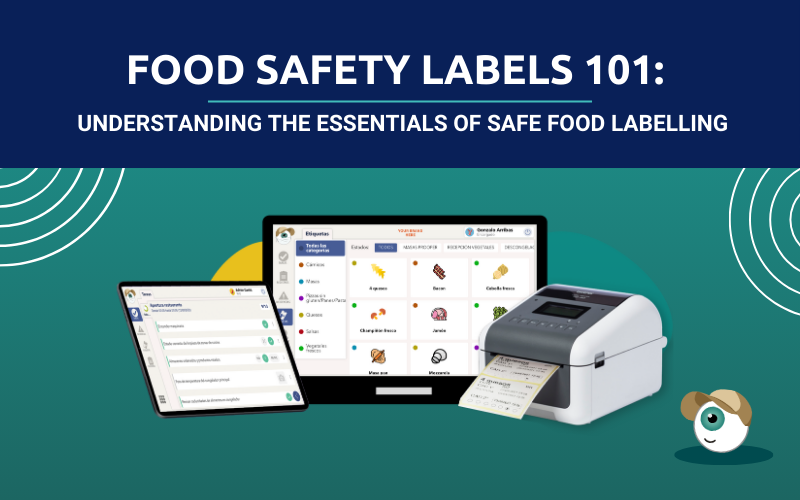Food Safety Labels 101: Understanding the Essentials of Safe Food Labelling
While creating mouthwatering dishes that truly delight our customers is key, their health and safety should always be at the top of our priorities.
That’s where food safety labels play a key role.
These labels are vital in ensuring transparency, building trust, and safeguarding consumer interests.
In this post, we will delve into the essential role of food safety labels, highlighting their significance as a foundational element within any reputable restaurant or food service business.
Food Safety Labels in European Restaurants: A Mandatory Commitment to Transparency and Health
When diners walk into a restaurant, they have certain expectations: delectable cuisine, warm ambience, and, most importantly, safe and wholesome meals.
Behind the scenes, an intricate web of regulations ensures that these expectations are met, and at the heart of this regulatory framework lies a critical element: food safety labels.
Across Europe, these labels are not just a recommendation but a legal requirement, playing an indispensable role in ensuring the well-being of consumers and maintaining the integrity of the food industry.
A Continent-Wide Commitment to Transparency
Europe is well-known for its stringent food safety standards, a commitment that emphasises safeguarding consumers and promoting transparency. Food safety labels are a crucial component of this transparency initiative.
From charming cafés in Paris to bustling trattorias in Rome, European restaurants are obligated to furnish precise and all-encompassing information regarding the food they offer. This entails essential details such as ingredient listings, allergen data, nutritional content, and, when relevant, expiry or “use by” dates.
While the fundamental principle of food safety labelling remains consistent throughout Europe, the particulars can vary across countries due to diverse culinary practices and regulatory frameworks.
The European Union (EU) establishes guidelines that member nations incorporate into their domestic laws, ensuring a baseline level of uniformity. Nonetheless, individual countries retain the flexibility to impose supplementary requisites or tailor certain aspects to fit their cultural and dietary nuances.
The Vital Role of Food Safety Labels in Commercial Kitchens
The operational dynamics of a commercial kitchen demand unwavering precision, efficient organisation, and an uncompromising commitment to safety.
Within this demanding environment, food safety labels emerge as the bedrock supporting the very essence of successful restaurants and food service establishments.
Let’s delve into the intricate significance of food safety labels, particularly highlighting primary and secondary expiry dates, within the intricate world of commercial kitchens.
Understanding Primary Expiry Dates
A primary expiry date, known as a “use by” date, signifies the point determined by food producers or manufacturers when a product is anticipated to attain its highest quality and safety.
This date primarily applies to perishable items with limited shelf lives, such as dairy products, fresh meats, and ready-to-eat meals.
Furthermore, primary expiry dates play an unequivocal role in ensuring food safety.
The perishable nature of many kitchen ingredients emphasises the criticality of adhering to these dates to mitigate the potential risks associated with serving compromised or unsafe food items.
Meticulously affixing food safety labels bearing primary expiry dates underscores commercial kitchens’ dedication to professionalism and the well-being of patrons.
Decoding Secondary Expiry Dates
In commercial kitchens, “secondary expiry dates” refer to the timeline within which a product should be consumed after it has been opened.
This is commonly referred to as the “secondary shelf life” or “open date.”
This timeline delineates the duration during which a product is projected to uphold its quality and safety following the initial packaging’s breach.
For example, products like sauces, condiments, and select perishable ingredients possess a limited timeframe post-unsealing during which they remain suitable and safe for consumption.
Precise labelling of secondary expiry dates is pivotal in commercial kitchens to guarantee that ingredients employed in recipes and dishes maintain optimal quality and don’t pose health hazards to patrons.
By adhering to secondary expiry dates and upholding rigorous inventory management practices, commercial kitchens enhance operational efficiency, minimise wastage, and ensure alignment with stringent food safety standards.
Food Safety Labels: Mitigating Allergen Risks
Food safety labels play a pivotal role in managing allergen risks, a concern that is often hidden but potentially severe. Allergies can manifest unexpectedly and with dire consequences. Food safety labels, in this context, emerge as the guardians for those vulnerable to allergens.
Ingredients known to trigger allergic reactions, such as nuts, dairy, gluten, and soy, are meticulously detailed on these labels.
The meticulousness of this process serves two essential purposes.
- Firstly, it aligns with legal mandates prevalent in many regions, underscoring the adherence to standards that prioritise consumer safety.
- Secondly, it signifies an ethical obligation to foster transparency and care.
The act of explicitly disclosing potential allergens resonates far beyond regulatory demands.
By transparently communicating these ingredients, establishments create a sanctuary for patrons. This environment extends reassurance, enabling individuals to dine with confidence and without unwarranted anxiety.
The profound significance of this safety practice should not be underestimated.
A secure dining experience etches a lasting impression in patrons’ minds, nurturing a sense of trust that can transcend a single visit. In fact, it is within such safe havens that the seeds of customer loyalty are sown and nurtured.
Traceability: From Farm to Fork
Consumers now demand a deeper understanding of their food’s journey – from its inception on the farm to its presentation on their plates.
This demand for transparency has given rise to the significance of traceability, a concept pivotal in maintaining integrity.
A crucial feature underpinning traceability is the utilisation of batch numbers, an integral facet of food safety labels.
While these alphanumeric sequences might appear arbitrary, they wield substantial influence.
Their role is to provide a trail that retraces the product’s path – its origin, the supplier involved, and the intricate nuances of its production process.
The value of batch numbers extends beyond routine operations.
In the unfortunate scenario of a foodborne illness outbreak, traceability becomes a potent tool for swift containment and effective rectification. The ability to pinpoint the exact source of a concern facilitates rapid responses, minimising risks and safeguarding consumer well-being.
In essence, traceability acts as both a proactive mechanism for establishing authenticity and a reactive safeguard against potential hazards. It aligns seamlessly with the evolving expectations of informed consumers while reinforcing the food industry’s commitment to accountability and safety.
Enhancing Efficiency and Cost Savings: The Pragmatic Value of Food Safety Labels
Food safety labels transcend their regulatory role to become indispensable tools that save time, money, and minimise errors in any culinary setting.
The strategic use of food safety labels streamlines operations by providing essential information at a glance.
This clarity reduces the time spent deciphering complex details and cross-referencing information.
Quick access to crucial data expedites decision-making, allowing kitchen staff to focus on what truly matters – creating exceptional dishes.
Precision is another hallmark of food safety labels.
By accurately conveying allergens, ingredients, and key information, the risk of mistakes is mitigated. This translates directly into savings, as fewer errors mean reduced rework, fewer discrepancies, and optimal resource allocation.
The result is not only financial gain but also a reputation for consistent professionalism.
In a competitive culinary landscape, embracing food safety labels becomes a strategic advantage. Compliance is just the beginning; these labels maximise efficiency, minimise waste, and contribute to a healthier bottom line.
As kitchens operate seamlessly, errors dwindle, and expenses decrease, the tangible impact of food safety labels on a culinary establishment’s financial landscape becomes evident.
Cultivating a Culture of Integrity: The Role of Food Safety Labels
Food safety labels serve not only as a response to regulatory requirements but also as emblematic storytellers of a restaurant’s commitment to integrity.
These labels, stemming from compliance mandates, transcend their functional role to embody the very essence of a food safety culture.
The effort invested in crafting precise, informative, and user-friendly labels goes beyond the realm of mere adherence. It symbolises a dedication to patron well-being, echoing through a broader commitment.
This commitment encompasses rigorous quality control practices, unwavering safety protocols, and a pervasive culture of excellence.
However, the significance deepens further.
Amid the surge of conscientious consumerism, the value of such a commitment becomes pronounced.
Diners now seek transparency and accountability from the establishments they choose. Restaurants that embrace meticulous labelling reflect an establishment-wide culture that prioritises safety and quality.
The narrative spun by these labels extends beyond regulatory compliance. It resonates as a declaration of the establishment’s ethos, a testament to its integrity, and a reinforcement of its dedication to deliver an experience aligned with the values of the discerning modern consumer.
In essence, food safety labels become a manifestation of a comprehensive food safety culture, a culture that distinguishes a restaurant and fosters unwavering patron loyalty.
Empowering Efficiency with Andy: Your Food Safety Digital Assistant
In the fast-paced world of culinary operations, every second counts.
Enter Andy, your food safety digital assistant, poised to revolutionise the way you manage food safety labels.
Andy isn’t just an assistant; it’s an innovative solution that transforms traditional labelling practices into a streamlined, time-saving, and cost-effective process.
Time Saver Extraordinaire
Andy thrives on efficiency.
Say goodbye to the manual effort of handwritten labels that demand precious time from your busy kitchen staff.
With Andy, creating digital food labels becomes a seamless task.
Instantly generate accurate and standardised labels with the tap of a few buttons. Imagine the cumulative hours saved, allowing your team to focus on what truly matters – crafting exceptional culinary creations.
Financial Friend
Andy’s impact on your bottom line is tangible.
By minimising errors and waste through precise digital labelling, Andy safeguards your resources.
No more inaccuracies due to illegible handwriting or overlooked details.
The result?
Reduced instances of rework, fewer discrepancies, and an optimised allocation of ingredients. Your budget thanks you as errors decrease and financial efficiency soars.
Precision and Perfection
Andy is a paragon of precision.
Its digital labels leave no room for ambiguity or misinterpretation.
Allergens, nutritional information, expiry dates – all the critical data is presented flawlessly, ensuring the highest standards of accuracy.
With Andy, you’re not just labelling; you’re presenting a meticulous standard that reflects your commitment to excellence.
By saving time, optimising resources, and minimising errors, Andy becomes an indispensable ally in your quest for culinary greatness.
Your kitchen transforms into a haven of efficiency, where every task, from labelling to crafting dishes, is executed with precision and finesse.
Try Andy App now and discover the many benefits of having this helpful Food Safety digital assistant helping your
restaurants/food service business’ teams!
👉🏽START 100% FREE HERE!👈🏽

